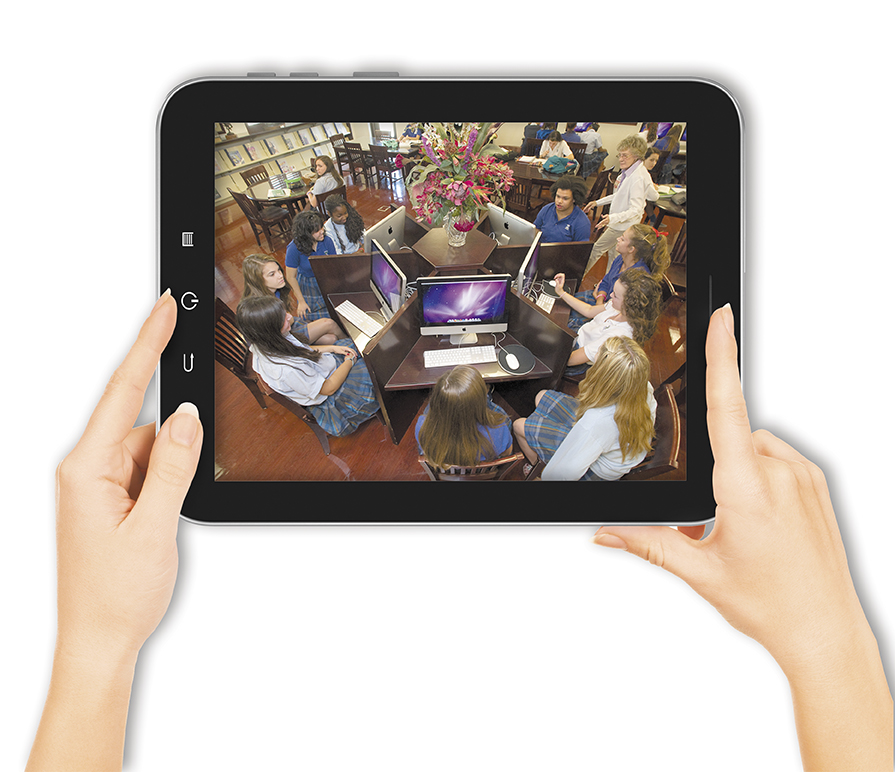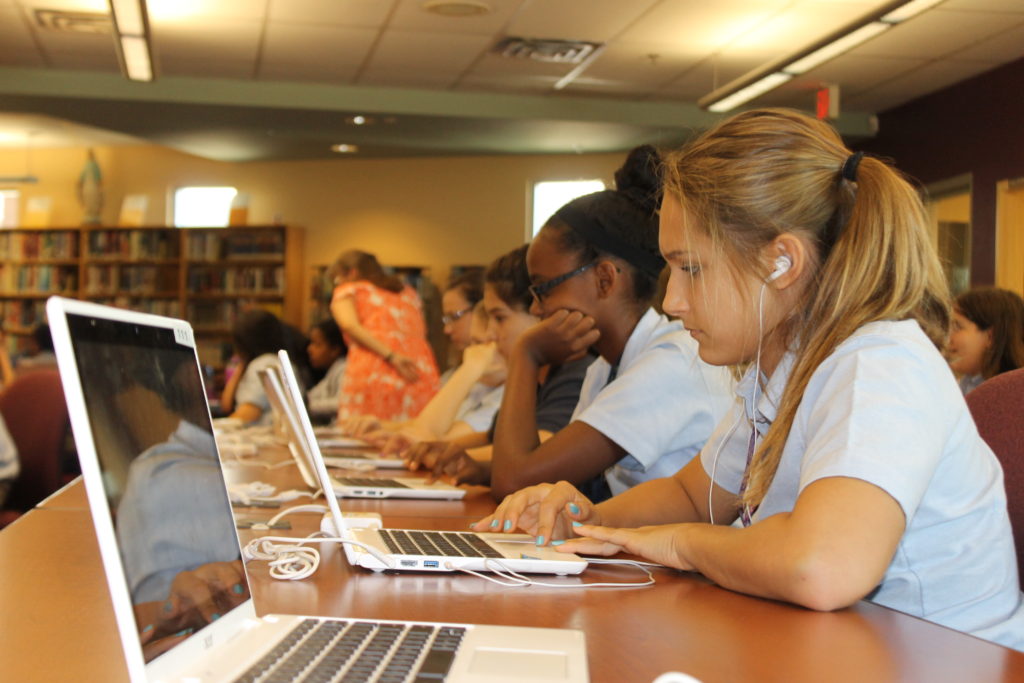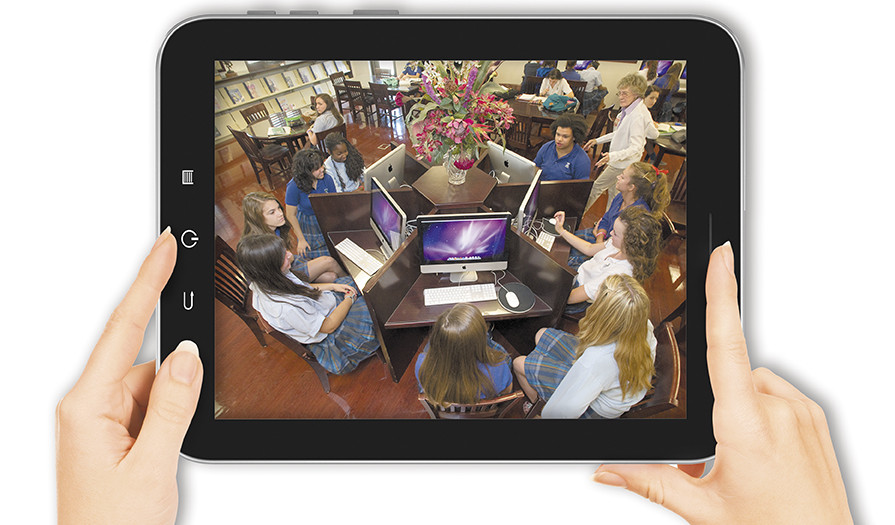
As the new school year begins, teachers are finding the integration of technology into curriculum and instruction is the norm rather than the exception. The proliferation of technology and social media has changed the way students learn, challenging educators to redefine approaches to teaching.
Throughout the Diocese of Phoenix teacher-student interactions reflect technology advancements.
“Our goal is not only to prepare them for heaven but for every challenge and accomplishment in life,” said MaryBeth Mueller, superintendent of Catholic Schools.
“With regard to technology, we strive for balance within our schools, to form our students’ responsible and Christian use of social media and to teach them that devices are just a small part and mere tools in their journey through life.”
Those tools — having made chalkboards and overheads obsolete — are now in the hands of students as young as three.
In many cases, children entering pre-kindergarten already have the knowledge of how to use technology to read a book, play interactive games or watch a movie.
“If you need help ask any young kid, it’s amazing what they know,” said Gregory Kirkham, principal of St. Joseph Catholic School in Cottonwood. “That’s the world we live in, it’s moving so fast.”
The student body of 158 students in grades pre-kindergarten through eighth grade will occupy a new school on the grounds of Immaculate Conception Parish that is wired for current technology trends, and stocked with an additional 79 new computers.
Educational technology is responsible for giving the chalkboard a facelift, twice, from a whiteboard to a Smart Board.
The interactive system uses a touch-sensitive white screen, a computer and a projector. Add to that a tool that allows students to use their smart devices to answer questions in “real time.”
“From paperless classrooms to more traditional and classical approaches, each school has a unique approach to implementing digital instruction,” Mueller said.
All diocesan schools use devices ranging from iPads and Chromebooks to Surface or other learning devices.
“However, the use of these tools looks different from school to school dependent upon professional development, the school’s mission, and the number of devices available, among other factors,” Mueller said.
Teachers at St. Joseph use a variety of educational technology to assess and assist students, and supplement curriculum to provide personalized instruction.

“It’s an ever-changing world,” Kirkham said, “and the real challenge is how do we prepare these kids for technology that isn’t available today but in the future.”
For the first time the Virginia G. Piper Charitable Trust awarded a $4.75 million grant last year to support and expand technology in the six diocesan high schools.
The grant allowed Bourgade Catholic High School the ability to purchase Canvas, a learning management system used by universities across the nation.
In addition, they have campus-wide Wi-Fi and increased bandwidth, making it possible for students to use any device they own for academic purposes.
“Bourgade Catholic is using technology innovatively to optimize our resources to provide personalized learning for our students so they will be prepared and confident as they move on to higher education,” said Kathryn Rother, principal.
“Knowledge and experience in the use and potential of computer technology is a requirement for 21st century learners.”
Educators agree that technology provides development in critical thinking, problem solving, collaboration, communication, innovation and creativity.
Digital learning, however, isn’t limited to devices but also refers to how students access information from online learning sites, applications and programs.
Two years ago Seton Catholic Preparatory High School developed the ability for students to meet their teachers in a virtual environment when they aren’t physically on campus.
This type of “virtual classroom” piqued the interest of Kirkham who is in a long-term project with Bourgade.
The goal is to develop and fund a program that would allow students in Northern Arizona the ability to continue their Catholic education in an interactive, virtual high school classroom.
“This could be the way to bring Catholic education to a small area, anywhere in Arizona, that doesn’t have the ability for a school or a staff,” Kirkham said. “We know the technology is capable and we are working towards it.”
Decisions are varied; from implementing a technological infrastructure to supporting a comprehensive educational plan, choices are not made easily.
“The biggest challenge is the investment of time,” said Christine Tax, principal of St. John Vianney School in Goodyear. “Technology is ever-changing. A five-year plan can change in four months.”
Funding can be another hurdle.
“As important as technology is to have in schools, it is difficult to achieve unless you get funding or a grant,” Tax said.
St. John Vianney is one of several schools participating in the federal E-rate program, which provides schools and libraries across the country with substantial discounts on technology services.
The discounts reduce the costs of telephone service, Internet access and the internal connections used to build and maintain the computer networks that link classrooms.
Discounts are based on the income level of the student’s families.
To avoid schools leaving money on the table Gene Rowley, an IT consultant for the past 14 years who works in both the private and public sectors, recommends using consultants.
“Any of our Catholic schools should apply. The trouble is a lot of schools don’t know how to do it and rely on consultants. That’s where you have to weigh the cost, Rowley said.”







